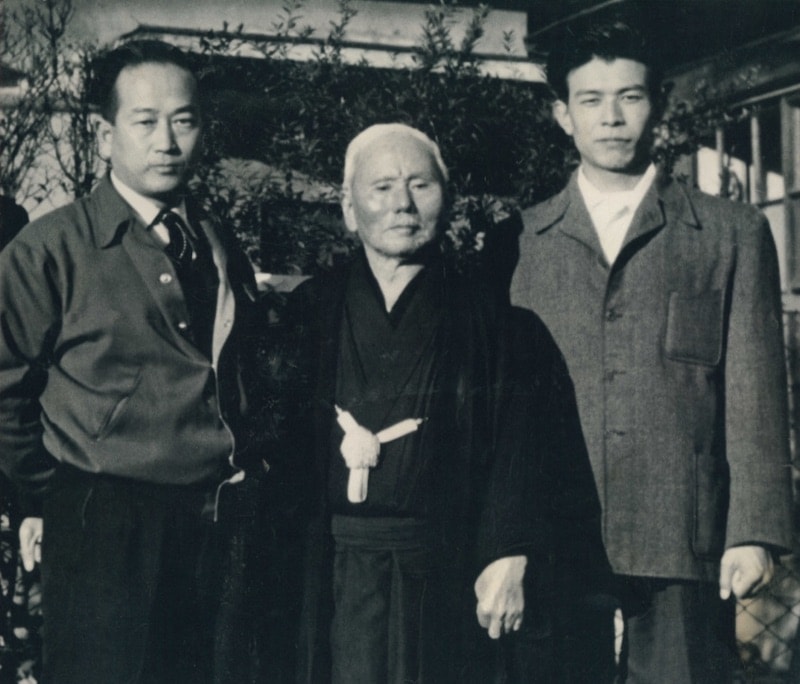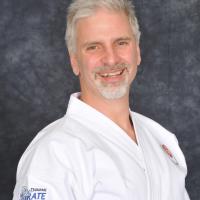Karate is for everyone who breathes and thinks.
In most schools of martial arts (any given practice from Japan is taught in a dojo, translated as "place of the way") you will find adult students who are indeed young, trim, and remarkably skilled. But dojos that consist only —or even mostly—of such practitioners are rare. Chief Instructors, if they are to keep the lights on, are wise to open their shoji screens to we who inhabit more common bodies. Those who'd look good in spandex and a cape occupy the far tail end of the bell curve. For every one of them, there are dozens of us who fall short of their prime example.
That is a good thing, and here's why: karate is for everyone who breathes and thinks. These are its only prerequisites. Beyond them there is no one, in any physical state or any mental state, who cannot begin the practice of karate.
That's a bold statement, bolder than claims of putting body parts through wood, cinder block, or flaming ice (should you find yourself desiring to do such a thing.) But it has the benefit of being the truth.
Don't get me wrong, there is excellence to be found. My point is that there is much space for the rest of us.
I've attended countless advanced classes with scores, and sometimes hundreds, of Black Belts. In these exclusive training sessions, the Hollywood-drenched mind might expect to find legions of chiseled bodies, all with perfect, sky-high, bladed kicks. While such physiques and skills do exist, there are also those of us who are shorter than normal. Or taller, or skinnier, or older, or a little plump around the middle, or lack a neurochemical or two, a functioning limb or two, an eye or two, or an ear or two. There are those of us who sometimes lose the struggle against our daily schedules to engage in this practice that we love.
There are others, possessing physical limitations that would overwhelm most of us, who manage no reduction of their attendance or enjoyment of karate classes. And, most often, there are people like me who, even if we did occupy that rarified physical space for a time, end up with a majority of training experience that precedes and succeeds it.
Karate at its Best
If I think my tournament medals and other former, physical glories are what this is all about, I'm making a systemic mistake, and I'm missing the best of what karate has to offer. Because of my practice, I can live a life in awareness of nuance and appreciation. I can occupy philosophical positions that others reject. I enter my 60s with surprisingly good health, and with many happy karate-born friendships, most often with people whose skill you'd never perceive from their physical appearance.
It's not about perfection. It's about striving, a concept available to all of us.
Karate is a craft; one whose excellence requires an open mind toward physical and mental education. Self-defense is present, yes, as are focus, discipline, and physical development. But in the true practice of ("stopping the conflict"), karate-do is a pathway that leads one to excellence in unexpected moments.
"Kara" means empty, "Te" means hand. We do not occupy our hands during Kara-Te. Its practice requires us to empty our minds as well, that they might better receive the gift of wakeful awareness. This is how we can bring the benefits of karate into the entirety of our lives. And this is a primary way in which I find our art so inviting. It's neither first nor mostly about being a physical specimen. If you can be observant, you can practice karate.

For more than four decades I've practiced Shotokan karate, known for its remarkable generation of direct force. My teacher often referred to it as a "focus of power." But even some of Shotokan karate's famous founders were, at one time, imperfect physical specimens. In 1879, Gichin Funakoshi began his training as a sickly, frail, 11- year-old Okinawan boy. Funakoshi's long life was punctuated by extraordinary accomplishments, including critical demonstrations to Japanese royalty that led to karate's inseparable association with Japanese culture. His scholarly work and revolutionary concepts empower students around the world to this day. Until his passing in the spring of 1957 at the venerable age of 88, Master Funakoshi repeatedly credited his energetic health to his karate training.
Over the past two decades I've built my own karate school based on the thinking presented here. While we have won plenty of tournament medals and trophies, they do not occupy space on our walls. Instead, we have images of challenging events and many smiles. At Granite Forest Dojo, all instructors hold true to Master Funakoshi's original teachings as presented by his most emulated students, Master Masatoshi Nakayama and Shihan Teruyuki Okazaki. The latter was my teacher for 36 years. As a result, karate here is an undiminished, welcoming, nurturing, enduring, venerated legacy that remains available to all.
The above is an original article by Bruce Costa. He is the author of the upcoming book, Welcome to Karate, publication date September 2021, YMAA Publication Center, ISBN: 9781594398414.


